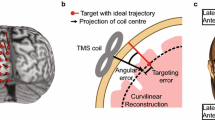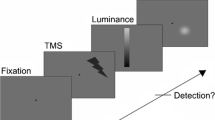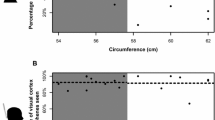Abstract
Transcranial magnetic stimulation (TMS) induces phosphenes and disrupts visual perception when applied over the occipital pole. Both the underlying mechanisms and the brain structures involved are still unclear. In the first part of this study we show that the masking effect of TMS differs to masking by light in terms of the psychometric function. Here we investigate the emergence of phosphenes in relation to perimetric measurements. The coil positions were measured with a stereotactic positioning device, and stimulation sites were characterized in four subjects on the basis of individual retinotopic maps measured by with functional magnetic resonance imaging. Phosphene thresholds were found to lie a factor of 0.59 below the stimulation intensities required to induce visual masking. They covered the segments in the visual field where visual suppression occurred with higher stimulation intensity. Both phosphenes and transient scotomas were found in the lower visual field in the quadrant contralateral to the stimulated hemisphere. They could be evoked from a large area over the occipital pole. Phosphene contours and texture remained quite stable with different coil positions over one hemisphere and did not change with the retinotopy of the different visual areas on which the coil was focused. They cannot be related exclusively to a certain functionally defined visual area. It is most likely that both the optic radiation close to its termination in the dorsal parts of V1 and back-projecting fibers from V2 and V3 back to V1 generate phosphenes and scotomas.






Similar content being viewed by others
References
Afra J, Mascia A, Gerard P, Maertens de Noordhout A, Schoenen J (1998) Interictal cortical excitability in migraine—a study using transcranial magnetic stimulation of motor and visual cortices. Ann Neurol 44:209–215
Amassian VE, Cracco RQ, Maccabee PJ (1989) Focal stimulation of human cerebral cortex with the magnetic coil: a comparison with electrical stimulation. Electroencephalogr Clin Neurophysiol 74:401–416
Amassian VE, Eberle L, Maccabee PJ, Cracco RQ (1992) Modelling magnetic coil excitation of human cerebral cortex with a peripheral nerve immersed in a brain-shaped volume conductor: the significance of fiber bending in excitation. Electroencephalogr Clin Neurophysiol 85:291–301
Amassian VE, Maccabee PJ, Cracco RQ, Cracco JB, Somasundaram M, Rothwell JC, Eberle L, Henry K, Rudell AP (1994) The polarity of the induced electric field influences magnetic coil inhibition of human visual cortex: implications for the site of excitation. Electroencephalogr Clin Neurophysiol 93:21–26
Amunts K, Malikovic A, Mohlberg H, Schormann T, Zilles K (2000) Brodmann’s areas 17 and 18 brought into stereotaxic space—where and how variable? Neuroimage 11:66–84
Aurora SK, Ahmad BK, Welch KMA, Bhardhwaj P, Ramadan NM (1998) Transcranial magnetic stimulation confirms hyperexcitability of occipital cortex in migraine. Neurology 50:1111–1114
Beckers G, Hömberg V (1991) Impairment of visual perception and visual short term memory scanning by transcranial magnetic stimulation of occipital cortex. Exp Brain Res 87:421–432
Beckers G, Zeki S (1995) The consequences of inactivating areas V1 and V5 on visual motion perception. Brain 118:49–60
Bohotin V, Fumal A, Vandenheede M, Gerard P, Bohotin C, de Noordhout AM, Schoenen J (2002) Effects of repetitive transcranial magnetic stimulation on visual evoked potentials in migraine. Brain 125:912–922
Boroojerdi B, Meister IG, Foltys H, Sparing R, Cohen LG, Töpper R (2002) Visual and motor cortex excitability: a transcranial magnetic stimulation study. Clin Neurophysiol 113:1501–1504
Brindley GS, Donaldson PE, Falconer MA, Rushton DN (1972) The extent of the region of occipital cortex that when stimulated gives phosphenes fixed in the visual field. J Physiol (Lond) 225:57P–58P
Corthout E, Uttl B, Walsh V, Hallett M, Cowey A (1999) Timing of activity in early visual cortex as revealed by transcranial magnetic stimulation. Neuroreport 10:2631–2634
Corthout E, Uttl B, Juan CH, Hallett M, Cowey A (2000) Suppression of vision by transcranial magnetic stimulation: a third mechanism. Neuroreport 11:2345–2349
Cowey A, Walsh V (2000) Magnetically induced phosphenes in sighted, blind and blindsighted observers. Neuroreport 11:3269–3273
Epstein CM, Zangaladze A (1996) Magnetic coil suppression of extrafoveal visual perception using disappearance targets. J Clin Neurophysiol 13:242–246
Epstein CM, Schwartzberg DG, Davey KR, Sudderth DB (1990) Localizing the site of magnetic brain stimulation in humans. Neurology 40:666–670
Epstein CM, Verson R, Zangaladze A (1996) Magnetic coil suppression of visual perception at an extracalcarine site. J Clin Neurophysiol 13:247–252
Felleman DJ, Van Essen DC (1991) Distributed hierarchical processing in the primate cerebral cortex. Cerebral Cortex 1:1–47
Fuhr P, Agostino R, Hallett M (1991) Spinal motor neuron excitability during the silent period after cortical stimulation. Electroencephalogr Clin Neurophysiol 81:257–262
Goebel R, Khorramsefat D, Muckli L, Hacker H, Singer W (1998) The constructive nature of vision—direct evidence from functional magnetic resonance imaging studies of apparent motion and motion imagery. Eur J Neurosci 10:1563–1573
Gothe J, Brandt SA, Irlbacher K, Roricht S, Sabel BA, Meyer BU (2002) Changes in visual cortex excitability in blind subjects as demonstrated by transcranial magnetic stimulation. Brain 125:479–490
Gregory RL (1970) The intelligent eye. McGraw-Hill, New York
Hasnain MK, Fox PT, Woldorff MG (1998) Intersubject variability of functional areas in the human visual cortex. Hum Brain Mapp 6:301–315
Hupe JM, James AC, Payne BR, Lomber SG, Girard P, Bullier J (1998) Cortical feedback improves discrimination between figure and background by V1, V2 and V3 neurons. Nature 394:784–787
Ilmoniemi RJ, Ruohonen J, Karhu J (1999) Transcranial magnetic stimulation—a new tool for functional imaging of the brain. Crit Rev Biomed Eng 27:241–284
Inghilleri M, Berardelli A, Cruccu G, Manfredi M (1993) Silent period evoked by transcranial stimulation of the human cortex and cervicomedullary junction. J Physiol (Lond) 466:521–534
Jalinous R (1991) Technical and practical aspects of magnetic nerve stimulation. J Clin Neurophysiol 8:10–25
Kamitani Y, Shimojo S (1999) Manifestation of scotomas created by transcranial magnetic stimulation of human visual cortex. Nat Neurosci 2:767–771
Kammer T (1999) Phosphenes and transient scotomas induced by magnetic stimulation of the occipital lobe: their topographic relationship. Neuropsychologia 37:191–198
Kammer T, Beck S (2002) Phosphene thresholds evoked by transcranial magnetic stimulation are insensitive to short-lasting variations in ambient light. Exp Brain Res 145:407–410
Kammer T, Nusseck HG (1998) Are recognition deficits following occipital lobe TMS explained by raised detection thresholds? Neuropsychologia 36:1161–1166
Kammer T, Erb M, Beck S, Grodd W (2000) Multimodal mapping of the visual cortex: comparison of functional MRI and stereotactic TMS. Eur J Neurosci 12 [Suppl] 11:192
Kammer T, Beck S, Erb M, Grodd W (2001a) The influence of current direction on phosphene thresholds evoked by transcranial magnetic stimulation. Clin Neurophysiol 112:2015–2021
Kammer T, Beck S, Thielscher A, Laubis-Herrmann U, Topka H (2001b) Motor thresholds in humans. A transcranial magnetic stimulation study comparing different pulseforms, current directions and stimulator types. Clin Neurophysiol 112:250–258
Kammer T, Puls K, Strasburger H, Hill NJ, Wichmann FA (2004) TMS in the visual system. I. The psychophysics of visual suppression. Exp Brain Res (http://dx.doi.org/10.1007/s00221-004-1991-1)
Kastner S, Paul I, Ziemann U (1998) Transient visual field defects induced by transcranial magnetic stimulation over the occipital lobe. Exp Brain Res 118:19–26
Kosslyn SM, Pascual-Leone A, Felician O, Camposano S, Keenan JP, Thompson WL, Ganis G, Sukel KE, Alpert NM (1999) The role of area 17 in visual imagery: convergent evidence from PET and rTMS. Science 284:167–170
Lee HW, Hong SB, Seo DW, Tae WS, Hong SC (2000) Mapping of functional organization in human visual cortex—electrical cortical stimulation. Neurology 54:849–854
Maccabee PJ, Amassian VE, Eberle LP, Cracco RQ (1993) Magnetic coil stimulation of straight and bent amphibian and mammalian peripheral nerve in vitro: locus of excitation. J Physiol (Lond) 460:201–219
Marg E, Rudiak D (1994) Phosphenes induced by magnetic stimulation over the occipital brain: description and probable site of stimulation. Optom Vis Sci 71:301–311
Meyer BU, Diehl RR, Steinmetz H, Britton TC, Benecke R (1991) Magnetic stimuli applied over motor cortex and visual cortex: influence of coil position and field polarity on motor responses, phosphenes, and eye movements. Electroencephalogr Clin Neurophysiol Suppl 43:121–134
Pascual-Leone A, Walsh V (2001) Fast backprojections from the motion to the primary visual area necessary for visual awareness. Science 292:510–512
Penfield W, Rasmussen T (1950) The cerebral cortex of man: a clinical study of localization and function. Macmillan, New York
Potts GF, Gugino LD, Leventon ME, Grimson WEL, Kikinis R, Cote W, Alexander E, Anderson JE, Ettinger GJ, Aglio LS, Shenton ME (1998) Visual hemifield mapping using transcranial magnetic stimulation coregistered with cortical surfaces derived from magnetic resonance images. J Clin Neurophysiol 15:344–350
Ray PG, Meador KJ, Epstein CM, Loring DW, Day LJ (1998) Magnetic stimulation of visual cortex: factors influencing the perception of phosphenes. J Clin Neurophysiol 15:351–357
Rothwell JC (1997) Techniques and mechanisms of action of transcranial stimulation of the human motor cortex. J Neurosci Methods 74:113–122
Sereno MI, Dale AM, Reppas JB, Kwong KK, Belliveau JW, Brady TJ, Rosen BR, Tootell RBH (1995) Borders of multiple visual areas in humans revealed by functional magnetic resonance imaging. Science 268:889–893
Sparing R, Mottaghy FM, Ganis G, Thompson WL, Töpper R, Kosslyn SM, Pascual-Leone A (2002) Visual cortex excitability increases during visual mental imagery—a TMS study in healthy human subjects. Brain Res 938:92–97
Stewart LM, Walsh V, Rothwell JC (2001) Motor and phosphene thresholds: a transcranial magnetic stimulation correlation study. Neuropsychologia 39:415–419
Talairach J, Tournoux P (1988) Co-planar stereotaxic atlas of the human brain. Thieme, Stuttgart
Acknowledgements
We thank Sandra Beck, Hans-Günther Nusseck, and Kuno Kirschfeld, for support and for many fruitful discussions.
Author information
Authors and Affiliations
Corresponding author
Rights and permissions
About this article
Cite this article
Kammer, T., Puls, K., Erb, M. et al. Transcranial magnetic stimulation in the visual system. II. Characterization of induced phosphenes and scotomas. Exp Brain Res 160, 129–140 (2005). https://doi.org/10.1007/s00221-004-1992-0
Received:
Accepted:
Published:
Issue Date:
DOI: https://doi.org/10.1007/s00221-004-1992-0




